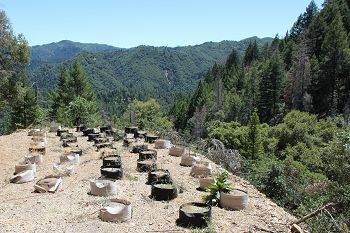Carah et al., 2015
High Time for Conservation: Adding the Environment to the Debate on Marijuana Liberalization
Carah, J., Howard, J., Thompson, S.E., Short Gianotti, A.G., Bauer, S., Carlson, S.M., Dralle, D.N., Gabriel, M.W., Hulette, L., Johnson, B., Knight, C., Kupferberg, S., Martin, S., Naylor, R., Power, M.E. (2015)
BioScience (Advance Access)
-
Eel, INVESTIGATOR
-
Eel, INVESTIGATOR
-
Eel, INVESTIGATOR, COLLABORATOR
-
Eel, INVESTIGATOR
-
Eel, COLLABORATOR
Abstract
A former marijuana cultivation site adjacent to the Shasta/Trinity National Forest. The site was illegally clear cut and graded to create the garden site, causing significant erosion as well as fragmentation of natural habitat. Photo by Jennifer Carah, TNC.
The liberalization of marijuana policies, including the legalization of medical and recreational marijuana, is sweeping the United States and other countries. Marijuana cultivation can have significant negative collateral effects on the environment that are often unknown or overlooked. Focusing on the state of California, where, by some estimates, 60%–70% of the marijuana consumed in the United States is grown, we argue that (a) the environmental harm caused by marijuana cultivation merits a direct policy response, (b) current approaches to governing the environmental effects are inadequate, and (c) neglecting discussion of the environmental impacts of cultivation when shaping future marijuana use and possession policies represents a missed opportunity to reduce, regulate, and mitigate environmental harm.
Citation
Carah, J., Howard, J., Thompson, S.E., Short Gianotti, A.G., Bauer, S., Carlson, S.M., Dralle, D.N., Gabriel, M.W., Hulette, L., Johnson, B., Knight, C., Kupferberg, S., Martin, S., Naylor, R., Power, M.E. (2015): High Time for Conservation: Adding the Environment to the Debate on Marijuana Liberalization. BioScience (Advance Access). DOI: 10.1093/biosci/biv083
 This Paper/Book acknowledges NSF CZO grant support.
This Paper/Book acknowledges NSF CZO grant support.
Explore Further






